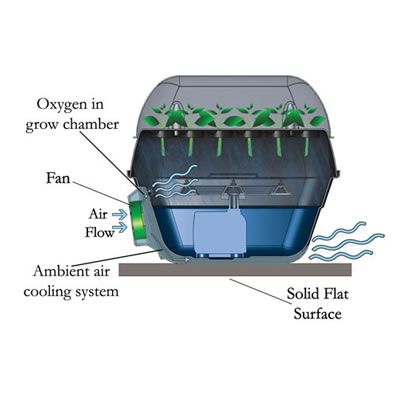Achieving 100% Strike Rate with Cuttings

A plant cutting, or clone, is a vegetative technique of reproducing plant genetics and quantities asexually. The methods vary in complexity according to the plant species, environmental conditions and desired results but in general, there are several techniques that can be utilized to increase your strike rate when cloning.
It’s worth mentioning that many different professional horticulturalists have a variety of different techniques, try to adapt the many different lessons into your own personal method for success!
Removing a section from the donor plant:
To begin, always ensure you use medically sterile tools and disinfect all surfaces prior to starting. Immediately after removing a cutting from a mother plant, we recommend to sit the seedling in a bowl of pH-balanced tap water. Using a scalpel, make a further cut at the base of the stem whilst the stem remains underwater. Ensuring the cut is made underwater minimizes pathogens getting into contact with the delicate plant tissue. Try to cut the stem on a 450 angle to increase surface area of the meristem and vascular bundle. Try to ensure your cuttings have at least two sets of leaves and two sets of nodes above the cut. Cuttings that are 10-20cm in length, taken from the middle of the plant tend to strike fastest!
Using Cloning Gel:
Once the cut has been made, gently plunge the cut stems into a reasonable amount of Ezi-Root. Ezi-Root contains both NAA and IBA. Studies have shown that a combination of these two rooting hormones is more effective then either used alone. We recommend pouring the required amount of gel onto a sterile dish; this prevents plant matter contaminating the bottle.
Once you have dipped the stems into your cloning gel, it’s time to tenderly place your seedlings into your desired medium, or ideally, into a TurboKlone aeroponic cloning appliance.
Propagation Media or Aeroponic Cloning?
TurboKlone provides a constant flow of aerated mist onto the base of the stems, encouraging rapid root development in a perfectly controlled environment. The first step preparing your TurboKlone is to use appropriate water.The best results we’ve seen have been utilizing RO Water (reverse osmosis) or some form of filtered water. Ideally the water temperature will sit between 180-230C and the room temperature will be roughly the same. Generally cuttings prefer a slightly warmer rootzone as this encourages faster tissue development. That being said, too warm and your cuttings will be more open to pathogen development and problems can occur. The pH of your water should be kept between 5.5 and 5.8, this can be achieved using pH up/down but try to be sparing with your nutriment and chemical use at this point.
Lighting:
Ensure you have appropriate lighting at a safe distance from the canopy. Our choice is T5 Fluorescent bulbs initially until the roots have struck. T5’s can be mounted directly on top of the humidity dome or roughly 8-12 inches from the top of the canopy.
In the first three days of the propagation process the unabsorbed cloning gel will wash off fairly quickly; this wash off will create a good nutrient base for the first 3 days. At day 4, now add a light dose of Roots Excelurator by House & Garden.There isn’t much uptake of nutrients prior to root nubs developing – hence, no adding Roots Excelurator until a few days into the grow cycle. It is also an option to also add 5ml of H2O2 (3% kind) at day 5. This helps freshen the grow chamber, prevents pathogen development and adds additional O2 – without harming the cuttings.
Humidity Dome:
The humidity dome should remain on until the clones’ root zone is strongly established and lateral root growth is clearly evident. This is generally around day 6-10 depending on your plant variety. Tapering the humidity down can be achieved by removing the humidity dome for successively longer periods each day after this period. The inbuilt fan of the TurboKlone helps to regulate temperatures of the rootzone and the air surrounding the unit. This encourages faster root development with less stress to your genetics.
If the environment is outside of the norm, water temperatures can be manipulated by either placing the system on the ground (coolest air will be on or near the floor – this will help get cooler temps). The cooler the water – the greater % of dissolved oxygen in the water. Or, raise the system on a shelf or table to increase temps slightly. If needed, use a heating pad under the reservoir to increase temperatures even more. In extreme hot conditions, a timer might be an option. Typically, all hydroponic systems suffer when in conditions warmer than 80+ degrees F (26.7 degrees C). Always make sure the system is on a flat surface. This will keep the air from the fan circulating along the side & bottom of the system. The constant flow of air against the system will help stabilize the water temperature & give you consistency.

Cleaning:
Always clean the system before a Kloning cycle (use H2O2 from the grocery store). Add the recommended amount of water in the reservoir (so that the intake grid on the pump is completely submerged), run the system for 30-45 minutes, then drain & rinse thoroughly.
Ensuring you have precise, healthy genetic replication of your plants is crucial for medical-grade cultivation. Regardless of your process or choice of propagation materials, always ensure you strive for cleanliness and efficiency. Don’t be afraid to try different techniques and document the results, it’s the best way to learn!
Lastly, if you’re having any difficulties or have any growing queries, hit up the Stealth Garden Team on social media! We are all avid gardeners and enthusiastic horticulturalists; we love to help with your questions!
